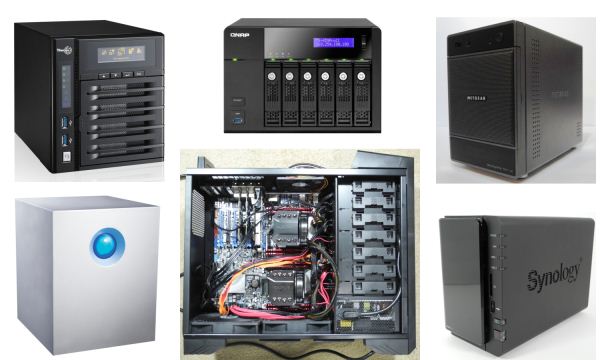Building the 2012 AnandTech SMB / SOHO NAS Testbed
by Ganesh T S on September 5, 2012 6:00 PM EST- Posted in
- IT Computing
- Storage
- NAS
Introduction & Goals of the Build
The market for network attached storage (NAS) devices has registered huge gains over the last few years. In keeping up with the market trends, the coverage of NAS units has also seen an uptick on AnandTech since the middle of 2010. Followers of our NAS reviews have seen the standard Intel NASPT benchmarks and file transfer test results along with a qualitative coverage of the NAS’s operating system / user interface. The reviews briefly touch upon miscellaneous factors such as power consumption. The feedback from the readers as well as the industry pointed towards some essential NAS aspects such as performance under loading from multiple clients being ignored. Towards the end of 2011, we started evaluating approaches to cover these aspects.
Our goal was to simulate a SMB (Small to Medium Business) / SOHO (Small Office / Home Office) type environment for the NAS under test. From the viewpoint of our testing, we consider a SMB as any setup with 5 - 25 distinct clients for the NAS. Under ideal circumstances, we could have had multiple PCs accessing the NAS at the same time. However, we wanted a testbed which didn’t require too much space or consume a lot of power. It was also necessary that the testbed be easily administered. These requirements ruled out the possibility of multiple distinct physical machines making up the testbed.
In order to set up multiple virtual machines (VMs), we wanted to build a multi-processor workstation. One of the primary challenges when running a large number of VMs on a single machine is the paucity of resources. It is important not to be disk bound. Therefore, we set out with the intent of providing each VM with its own processor core, physical primary disk and network port. After taking a look at the options, we decided to build a dual processor workstation capable of running up to 12 VMs. In the first four sections, we will take a look at the hardware options that we chose for the build.
Following the discussion of the hardware aspects, we have a section on the software infrastructure. This includes details of the host and guest operating systems, the benchmarking software and scripts used in the testing process. We initially gave a trial run of the new test components on two different NAS units, the Synology DS211+ and the Thecus N4800. Results from the new test components are presented in the two sections preceding the concluding remarks.











74 Comments
View All Comments
waldo - Wednesday, September 5, 2012 - link
Some of the biggest problems I have found in running my small business related to NAS's is file integrity under load. Is there a way to see if they have file integrity issues under load? Not just i/o or response times.Also, it would be interesting to see how their "feature set" holds up under load, as all of the NAS's purport to offer a variety of additional services other than purely file access/storage. Or is that only applicable to your lengthier reviews?
Lastly, most of these nas's don't have version tracking or something similar, so in a media setup, it would be interesting to see how they handle accessing the same file at the same time....can they serve it multiple times to multiple clients?
waldo - Wednesday, September 5, 2012 - link
One last thought...it would be interesting to see free nas or some other DIY as an alternative.Peanutsrevenge - Wednesday, September 5, 2012 - link
Top marks!Bet it was satisfying when the SSH script was comlpete, just press this button and .....
tygrus - Thursday, September 6, 2012 - link
How big a NAS can you test ? Does the server slow it down when testing 7+ virtual client load against NAS ? What is the client/host CPU usage, host system_cpu%, VM overhead ?Please test the server by running simultaneous tests to multiple NAS. Compare 6 clients alone to 1 NAS at a time with 2 sets of 6 clients to 2 NAS (or 3x4, 4x3). Is there any difference ? Is the test affected by the testbed CPU speed (try using a faster CPU eg. E5-2670) ? Can you test 16 or 24 clients (1 server) with 2 VM / SSD. Might need more RAM ? Now we are getting less SMB / SOHO and more enterprise :)
jwcalla - Thursday, September 6, 2012 - link
I got a bit of a chuckle out of G.Skill sending you non-ECC RAM.ganeshts - Thursday, September 6, 2012 - link
That is OK for our application :) We aren't running this workstation in a 'production' environment.bobbozzo - Thursday, September 6, 2012 - link
Curious, would ECC RAM use noticeably more power?extide - Thursday, September 6, 2012 - link
Why would they bother with ECC ram? Totally un-needed for this application..bsd228 - Monday, September 10, 2012 - link
ECC is absolutely needed for this application - Data integrity matters, not just data throughput.bobbozzo - Thursday, September 6, 2012 - link
Page 2, in the sentence"Out of the three processors, we decided to go ahead with the hexa-core Xeon E5-2630L"
The URL in the HREF has a space in it, and therefore doesn't work.
Thanks for the article!